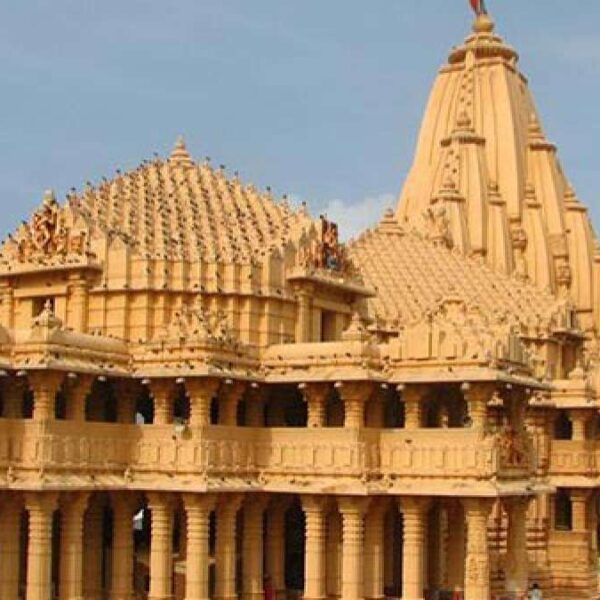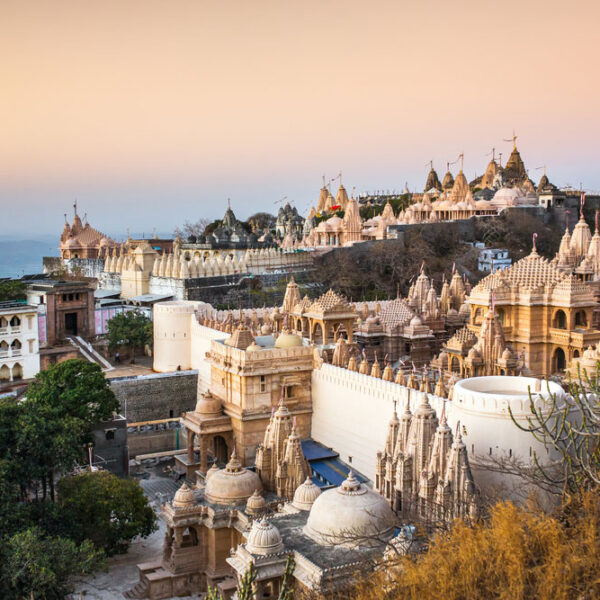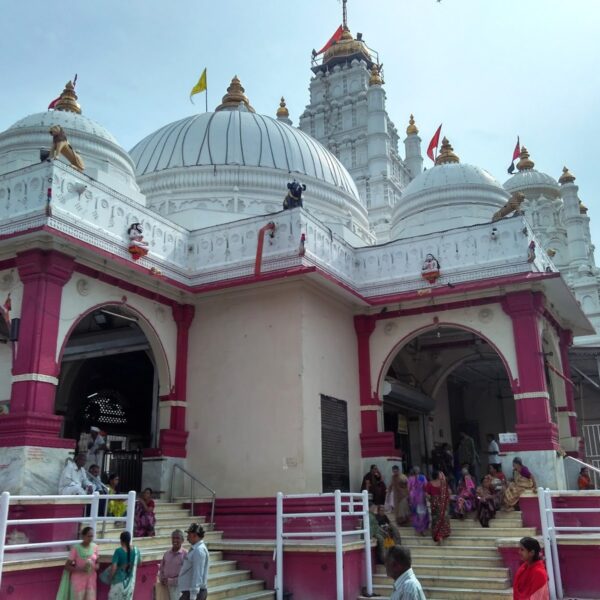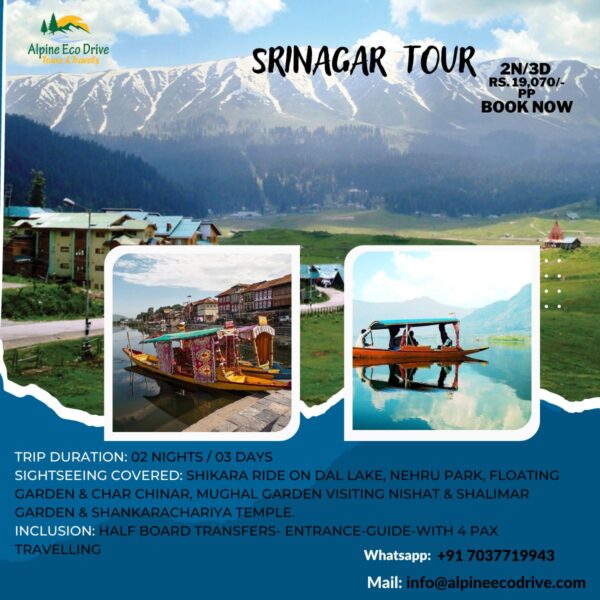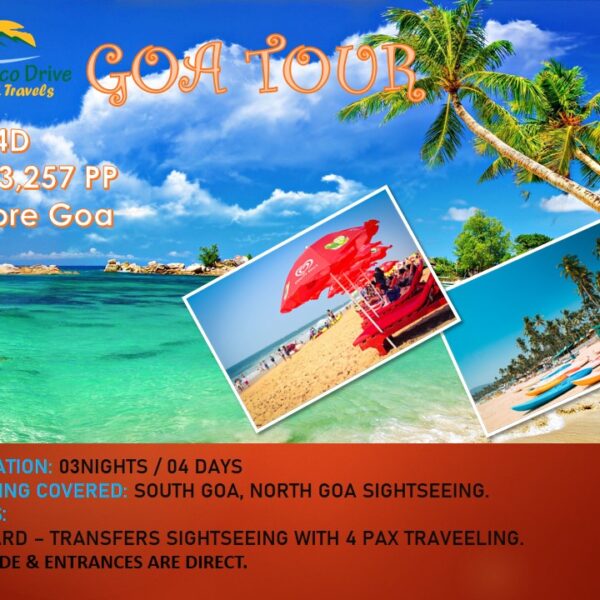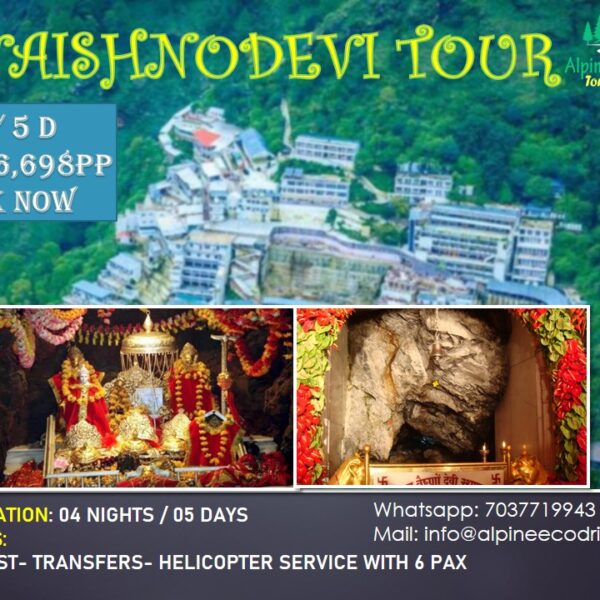Pilgrimage Tour Gujarat (7N/8D)
Destinations Covered: Ahmedabad – Dakor – Pavagadh – Ahmedabad – Dwarka – Somnath – Bhavnagar – Ahmedabad
Day 01: Arrive Ahmedabad by Air/Train
Arrive Ahmedabad and transfer to your hotel.
Ahmedabad is Located on the banks of the river Sabarmati; the city was founded by Sultan Ahmad Shah in 1411. Today it is one of the fastest growing cities of India and is an immense repository of tradition, history & culture.
Gandhi Ashram: On a quiet peaceful stretch of the Sabarmati River, Mahatma Gandhi set up a simple retreat in 1915. This was his Satyagrah Ashram and for many years it was the nerve centre of India’s freedom movement. It was from here, in 1930, that Mahatma began his famous Dandi March to the sea to protest the Salt Tax imposed by the British. Hridaya Kunj, the simple cottage where he lived, is now a national monument and preserved as it was during the Mahatma’s lifetime.
Sidi Sayed Mosque: One part of the wall in the old citadel of the mosque built by Ahmed Shah’s slave, Sidi Sayed, is celebrated the world over for its exquisite stone window tracery – a superb & peerless example of delicate carving that transforms stone into filigree.
Jumma Masjid: The Friday mosque was built by the city’s founder, Sultan Ahmed Shah, in 1423. Built of yellow sandstone in an architectural style that combines the best of Muslim & Hindu traditions. It stands on 260 pillars that support 15 domes at varying elevations.
Akshardham: Lord Swaminarayan, born in Chapaya in Uttar Pradesh, took a seven-year pilgrimage in Gujarat to preach his religion. He built six temples, the first being at Kalupur in Ahmedabad. Akshardham, the Swaminarayan temple of Gandhinagar, is a modern complex, built in traditional Indian architectural style from 6,000 metric tons of pink Rajasthan sandstone, carved by expert artisans from Bansipahadpur. The temple is set in a multi-acre garden called Sahajanand Van, with intricate sculptures of Hindu Gods.
The interiors have beautiful columns in rosewood that rise up to a high dome. Akshardham remains closed on Mondays.
Overnight at hotel.
Day 02: Ahmedabad (Day Excursion to Dakor-Pavagadh)
Dakor, in its earlier phases as pilgrimage centre in Gujarat, was famous for the Danknath temple, a place of Shiva worship. In the later phases, it developed into a Vaishnavites centre with the growing fame of Ranchhodraiji temple, which was built in 1772 A.D. Today this place is known not only as a pilgrimage centre but also a trading centre where one can get the articles related to puja, and other rituals.
Pavagadh: Most of the Hindus in India have faith in goddess Mahakali, particularly from the western region covering the states of Gujarat, Rajasthan & Maharashtra. The famous and the oldest temple of Mahakali is situated at Pavagadh, near Vadodara, one of the main cities of Gujarat. The temple has become the place of the pilgrimage for almost all Hindus in India. This temple is among the three main Shaktipeeths in Gujarat. It has been said in Hindu Shastras that after the famous Tandava dance of Lord Shiva, the various parts of the body of Sati fell at many places. These places are called Shaktipeeths. It is said that the left breast of the Sati had fallen here at Pavagadh. As the name suggests, the temple is located on a mountain, near to the Champaner town. Later drive back to Ahmedabad.
Overnight at hotel.
Day 03: Ahmedabad-Dwarka (450 Kms/09 hrs)
On arrival at Dwarka, checkin at the Hotel.
Dwarka: An ancient city, housing one of the principal pilgrimages – ‘Dwarkadhish temple’ of Hindus. According to the legend, Lord Krishna moved to this coastal town to set up a capital. Marine excavations of the Dwarka coast have revealed important evidences of ancient city, which probably include the ‘Dwarawati’ of the ‘Krishna Lila’. Today, it is not only a major pilgrimage site but a pleasant spot for a beach holiday. Another popular place in Dwarka, part of the Dwarkadhish Temple is Sabha Mandapa. It is a 60-pillared hall, which houses almost 2500 years old scriptures. The hall has ‘Jharokhas’, offering a nice view of the nearby flowing Gomati River. Attend evening Aarti at Dwarkadhish temple.
Overnight at hotel.
Day 04: Dwarka
After breakfast visit Bet Dwarka & Nageshwar temple. Bet Dwarka: Bet is situated at 30kms from Dwarka and is surrounded by sea from all sides. One can reach Bet from Dwarka through Okha by road. On reaching Okha port jetty, one can reach Bet through a little sea journey by a small boat. Nageshwar Temple or Nagnath Temple is located on the route between Gomati Dwarka and the Bet Dwarka Island on the coast of Saurashtra in Gujarat. The Jyotirlinga enshrined in the Temple of Nagnath is known as Nageshwar Mahadev and attracts thousands of pilgrims all around the year. This powerful Jyotirlinga symbolizes protection from all poisons. It is said that those who pray to the Nageshwar Lingaa become free of poison. The Rudra Samhita shloka refers to Nageshwar with the phrase ‘Daarukaavane Naagesham’.
The Rukmini temple, dating from 12 to 13 Century, was built in honour of Rani Rukmani, princess of Vidharba, which was to be married to Sishupala, but fled with Lord Krishna. This small temple, 1.5 km north of the city, is an architectural masterpiece. The temple walls are decorated with beautiful paintings and sculptures.
Gopi Talav: This is the place where Lord Krishna used to play with his Gopikas. There is a small pond where it is said that Lord Krishna used to play with the Gopika Strees (Gopika Women).
Overnight at hotel.
Day 05: Dwarka-Somnath (250 Kms/05 hrs)
Early morning visits the Dwarkadhish Temple and witness the Aarti.
After breakfast drive to Somnath visiting Porbandar enroute.
Porbandar, the coastal heritage town of Gujarat is located on the Saurashtra peninsula, on the Arabian Sea. This city is described in Skanda Purana as Sudamapuri and Ashmavati and had a flourishing trade with Africa and Arabia. Till date, the spice market in Porbandar draws a huge crowd. According to the legends, this city was the main link of the great friendship between Lord Krishna and Sudama. Porbandar was established as a capital by Rana Sartanji in 1785 AD. Porbandar was the former capital of the Jethwa Rajput petty princely state. The most impressive feature of Porbandar is the city planning and the stone buildings with ashlar masonry and rich carving, the facades of the houses on either side of the streets, with windows and carved gateways. Porbandar is also associated with Mahatma Gandhi, the father of the nation as he was born here. Today, fine quality silk and cotton are manufactured here. There are also chemical factories and cement works.
Later visit Kirti Mandir – Kirti Mandir was the house of Mahatma Gandhi and Kasturba, his wife. This place is situated near the place where the Mahatma was born. This place is now a small museum and also has a Gandhian library and a prayer hall. Bharat Mandir is another place to visit, which houses relief map of India and reliefs of great historical personalities who shaped India’s future.
Later continue to drive to Somnath; arrive Somnath and transfer to your hotel.
Somnath consists of a few streets leading away from its phoenix like temple. The rugged sea below gives it a lonely, wistful charm. Somnath is mainly known for the legendary shore temple of Somnath, which is dedicated to the Lord Shiva. The temple is an example of grit and determination and how to rise out of downfall as the temple has been plundered and destroyed many times and re-erected again in all its glory. To be precise, destroyed seven times and built eight!
The legendary shore temple of Somnath is one of the twelve most sacred shrines dedicated to the Lord Shiva. The temple contains the Jyotirlinga of Lord Shiva. According to the legends, the Somnath temple is very old and was originally built in gold by the Somraj, the Moon God. Later, it was rebuilt by Ravana, in silver; then by Krishna in wood and Bhim Dev in stone. Mahmud of Ghazni, upon hearing the description of the richness of the Somnath temple by Al Biruni, an Arab traveller, visited this temple in 1024 AD. At that time, this temple had about 300 musicians, 500 dancing girls and 300 barbers to shave off the heads of pilgrims. After a two day’s battle, Mahmud destroyed the temple and carried away jewels and gold to his homeland. In all, the Somnath temple was rebuilt and destroyed eight times. This temple was finally rebuilt in 1950 with the support of Sardar Vallabhabhai Patel..
Later visit Rudreshvara Temple – Rudreshvara Temple is a ruined temple located near the Somnath temple. Bhalka Tirth – Bhalka Tirth is situated halfway between Veraval and Somnath. At this place, Lord Krishna was mistaken for a deer and wounded by an arrow. It is here that Lord Krishna decided to leave his human form and proceed to the eternal world.
Overnight at hotel.
Day 06: Somnath-Bhavnagar (280 Kms/06 hrs)
After breakfast drive to Bhavnagar; arrive Bhavnagar and transfer to hotel.
Bhavnagar was founded by Bhavsinhji Gohil in 1723 AD near the Gulf of Khambhat, on a carefully chosen strategic location having potential of maritime trade. Till independence, Bhavnagar State was ruled by the Gohil Rajput clan. Gaurishanker Lake: A beautiful picnic spot near the lake. There is also a well laid out park. Takhteshwar Temple: Situated on a hill, the site provides a panoramic view. Lock Gate: The first of its kind in Gujarat. The seawater here is impounded by the lock gates to keep ships afloat during low tide, which could be seen with special permission.
Overnight at hotel.
Day 07: Bhavnagar
Early morning proceed for an excursion to Palitana.
Palitana: A 56kms drive from Bhavnagar. Palitana lies at the foot of the Shetrunjaya hill, with the Shetrunjaya River flowing to its south. The sacred hill rises in a crescendo of magnificent temples – 863 in all – that soar in marble splendour to the top of the hill. The temples were built over an impressive span of 900 years with each generation of pilgrims making its contribution to the shrines of Shetrunjaya. The 600-metre climb to Shetrunjaya is usually made on foot. Dolis or lift-chairs are also available for the ascent.
Overnight at hotel.
Day 08: Bhavnagar-Ahmedabad (200 Kms/04 hrs)
After breakfast drive back to Ahmedabad. Arrive Ahmedabad and in time transfer to Airport / Railway Station to board your flight / train for onward journey to your next destination.
Included/Exclude
CONTACT OUR TOUR EXPERTS
Related Tours
Review Scores
Destinations Covered: Ahmedabad – Dakor – Pavagadh – Ahmedabad – Dwarka – Somnath – Bhavnagar – Ahmedabad
Day 01: Arrive Ahmedabad by Air/Train
Arrive Ahmedabad and transfer to your hotel.
Ahmedabad is Located on the banks of the river Sabarmati; the city was founded by Sultan Ahmad Shah in 1411. Today it is one of the fastest growing cities of India and is an immense repository of tradition, history & culture.
Gandhi Ashram: On a quiet peaceful stretch of the Sabarmati River, Mahatma Gandhi set up a simple retreat in 1915. This was his Satyagrah Ashram and for many years it was the nerve centre of India’s freedom movement. It was from here, in 1930, that Mahatma began his famous Dandi March to the sea to protest the Salt Tax imposed by the British. Hridaya Kunj, the simple cottage where he lived, is now a national monument and preserved as it was during the Mahatma’s lifetime.
Sidi Sayed Mosque: One part of the wall in the old citadel of the mosque built by Ahmed Shah’s slave, Sidi Sayed, is celebrated the world over for its exquisite stone window tracery – a superb & peerless example of delicate carving that transforms stone into filigree.
Jumma Masjid: The Friday mosque was built by the city’s founder, Sultan Ahmed Shah, in 1423. Built of yellow sandstone in an architectural style that combines the best of Muslim & Hindu traditions. It stands on 260 pillars that support 15 domes at varying elevations.
Akshardham: Lord Swaminarayan, born in Chapaya in Uttar Pradesh, took a seven-year pilgrimage in Gujarat to preach his religion. He built six temples, the first being at Kalupur in Ahmedabad. Akshardham, the Swaminarayan temple of Gandhinagar, is a modern complex, built in traditional Indian architectural style from 6,000 metric tons of pink Rajasthan sandstone, carved by expert artisans from Bansipahadpur. The temple is set in a multi-acre garden called Sahajanand Van, with intricate sculptures of Hindu Gods.
The interiors have beautiful columns in rosewood that rise up to a high dome. Akshardham remains closed on Mondays.
Overnight at hotel.
Day 02: Ahmedabad (Day Excursion to Dakor-Pavagadh)
Dakor, in its earlier phases as pilgrimage centre in Gujarat, was famous for the Danknath temple, a place of Shiva worship. In the later phases, it developed into a Vaishnavites centre with the growing fame of Ranchhodraiji temple, which was built in 1772 A.D. Today this place is known not only as a pilgrimage centre but also a trading centre where one can get the articles related to puja, and other rituals.
Pavagadh: Most of the Hindus in India have faith in goddess Mahakali, particularly from the western region covering the states of Gujarat, Rajasthan & Maharashtra. The famous and the oldest temple of Mahakali is situated at Pavagadh, near Vadodara, one of the main cities of Gujarat. The temple has become the place of the pilgrimage for almost all Hindus in India. This temple is among the three main Shaktipeeths in Gujarat. It has been said in Hindu Shastras that after the famous Tandava dance of Lord Shiva, the various parts of the body of Sati fell at many places. These places are called Shaktipeeths. It is said that the left breast of the Sati had fallen here at Pavagadh. As the name suggests, the temple is located on a mountain, near to the Champaner town. Later drive back to Ahmedabad.
Overnight at hotel.
Day 03: Ahmedabad-Dwarka (450 Kms/09 hrs)
On arrival at Dwarka, checkin at the Hotel.
Dwarka: An ancient city, housing one of the principal pilgrimages – ‘Dwarkadhish temple’ of Hindus. According to the legend, Lord Krishna moved to this coastal town to set up a capital. Marine excavations of the Dwarka coast have revealed important evidences of ancient city, which probably include the ‘Dwarawati’ of the ‘Krishna Lila’. Today, it is not only a major pilgrimage site but a pleasant spot for a beach holiday. Another popular place in Dwarka, part of the Dwarkadhish Temple is Sabha Mandapa. It is a 60-pillared hall, which houses almost 2500 years old scriptures. The hall has ‘Jharokhas’, offering a nice view of the nearby flowing Gomati River. Attend evening Aarti at Dwarkadhish temple.
Overnight at hotel.
Day 04: Dwarka
After breakfast visit Bet Dwarka & Nageshwar temple. Bet Dwarka: Bet is situated at 30kms from Dwarka and is surrounded by sea from all sides. One can reach Bet from Dwarka through Okha by road. On reaching Okha port jetty, one can reach Bet through a little sea journey by a small boat. Nageshwar Temple or Nagnath Temple is located on the route between Gomati Dwarka and the Bet Dwarka Island on the coast of Saurashtra in Gujarat. The Jyotirlinga enshrined in the Temple of Nagnath is known as Nageshwar Mahadev and attracts thousands of pilgrims all around the year. This powerful Jyotirlinga symbolizes protection from all poisons. It is said that those who pray to the Nageshwar Lingaa become free of poison. The Rudra Samhita shloka refers to Nageshwar with the phrase ‘Daarukaavane Naagesham’.
The Rukmini temple, dating from 12 to 13 Century, was built in honour of Rani Rukmani, princess of Vidharba, which was to be married to Sishupala, but fled with Lord Krishna. This small temple, 1.5 km north of the city, is an architectural masterpiece. The temple walls are decorated with beautiful paintings and sculptures.
Gopi Talav: This is the place where Lord Krishna used to play with his Gopikas. There is a small pond where it is said that Lord Krishna used to play with the Gopika Strees (Gopika Women).
Overnight at hotel.
Day 05: Dwarka-Somnath (250 Kms/05 hrs)
Early morning visits the Dwarkadhish Temple and witness the Aarti.
After breakfast drive to Somnath visiting Porbandar enroute.
Porbandar, the coastal heritage town of Gujarat is located on the Saurashtra peninsula, on the Arabian Sea. This city is described in Skanda Purana as Sudamapuri and Ashmavati and had a flourishing trade with Africa and Arabia. Till date, the spice market in Porbandar draws a huge crowd. According to the legends, this city was the main link of the great friendship between Lord Krishna and Sudama. Porbandar was established as a capital by Rana Sartanji in 1785 AD. Porbandar was the former capital of the Jethwa Rajput petty princely state. The most impressive feature of Porbandar is the city planning and the stone buildings with ashlar masonry and rich carving, the facades of the houses on either side of the streets, with windows and carved gateways. Porbandar is also associated with Mahatma Gandhi, the father of the nation as he was born here. Today, fine quality silk and cotton are manufactured here. There are also chemical factories and cement works.
Later visit Kirti Mandir – Kirti Mandir was the house of Mahatma Gandhi and Kasturba, his wife. This place is situated near the place where the Mahatma was born. This place is now a small museum and also has a Gandhian library and a prayer hall. Bharat Mandir is another place to visit, which houses relief map of India and reliefs of great historical personalities who shaped India’s future.
Later continue to drive to Somnath; arrive Somnath and transfer to your hotel.
Somnath consists of a few streets leading away from its phoenix like temple. The rugged sea below gives it a lonely, wistful charm. Somnath is mainly known for the legendary shore temple of Somnath, which is dedicated to the Lord Shiva. The temple is an example of grit and determination and how to rise out of downfall as the temple has been plundered and destroyed many times and re-erected again in all its glory. To be precise, destroyed seven times and built eight!
The legendary shore temple of Somnath is one of the twelve most sacred shrines dedicated to the Lord Shiva. The temple contains the Jyotirlinga of Lord Shiva. According to the legends, the Somnath temple is very old and was originally built in gold by the Somraj, the Moon God. Later, it was rebuilt by Ravana, in silver; then by Krishna in wood and Bhim Dev in stone. Mahmud of Ghazni, upon hearing the description of the richness of the Somnath temple by Al Biruni, an Arab traveller, visited this temple in 1024 AD. At that time, this temple had about 300 musicians, 500 dancing girls and 300 barbers to shave off the heads of pilgrims. After a two day’s battle, Mahmud destroyed the temple and carried away jewels and gold to his homeland. In all, the Somnath temple was rebuilt and destroyed eight times. This temple was finally rebuilt in 1950 with the support of Sardar Vallabhabhai Patel..
Later visit Rudreshvara Temple – Rudreshvara Temple is a ruined temple located near the Somnath temple. Bhalka Tirth – Bhalka Tirth is situated halfway between Veraval and Somnath. At this place, Lord Krishna was mistaken for a deer and wounded by an arrow. It is here that Lord Krishna decided to leave his human form and proceed to the eternal world.
Overnight at hotel.
Day 06: Somnath-Bhavnagar (280 Kms/06 hrs)
After breakfast drive to Bhavnagar; arrive Bhavnagar and transfer to hotel.
Bhavnagar was founded by Bhavsinhji Gohil in 1723 AD near the Gulf of Khambhat, on a carefully chosen strategic location having potential of maritime trade. Till independence, Bhavnagar State was ruled by the Gohil Rajput clan. Gaurishanker Lake: A beautiful picnic spot near the lake. There is also a well laid out park. Takhteshwar Temple: Situated on a hill, the site provides a panoramic view. Lock Gate: The first of its kind in Gujarat. The seawater here is impounded by the lock gates to keep ships afloat during low tide, which could be seen with special permission.
Overnight at hotel.
Day 07: Bhavnagar
Early morning proceed for an excursion to Palitana.
Palitana: A 56kms drive from Bhavnagar. Palitana lies at the foot of the Shetrunjaya hill, with the Shetrunjaya River flowing to its south. The sacred hill rises in a crescendo of magnificent temples – 863 in all – that soar in marble splendour to the top of the hill. The temples were built over an impressive span of 900 years with each generation of pilgrims making its contribution to the shrines of Shetrunjaya. The 600-metre climb to Shetrunjaya is usually made on foot. Dolis or lift-chairs are also available for the ascent.
Overnight at hotel.
Day 08: Bhavnagar-Ahmedabad (200 Kms/04 hrs)
After breakfast drive back to Ahmedabad. Arrive Ahmedabad and in time transfer to Airport / Railway Station to board your flight / train for onward journey to your next destination.



